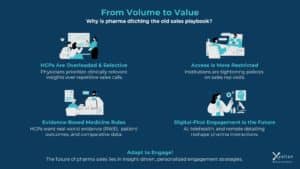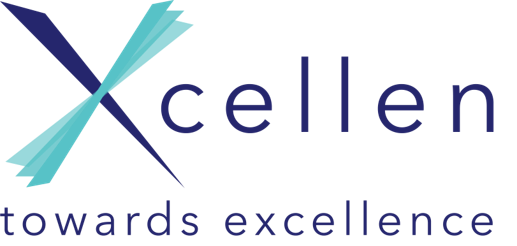Introduction
Shaped by rapid technological advancements, evolving regulatory frameworks, and shifting customer expectations the pharmaceutical industry is at a pivotal point. pharma companies are under increasing pressure to enhance commercial excellence and sales force effectiveness while staying agile in a competitive and unpredictable environment.
One of the most significant transformations is the shift from traditional sales models to more value-driven, customer-centric approaches. Healthcare providers (HCPs), payers, and patients now demand more than just product information—they seek tailored solutions, data-backed insights, and a seamless engagement experience. Simultaneously, the rise of digital health, AI-driven decision-making, and supply chain vulnerabilities are redefining how sales teams operate.
The question remains: how can sales organizations evolve to meet these demands while maintaining efficiency and strong customer relationships?
This two-part blog will explore the evolving definition of sales force effectiveness beyond 2025.
In Part 1, we’ll examine why traditional SFE models need an overhaul and explore two key trends reshaping pharma sales strategies:
- Value-based engagement over volume-based selling
- Aligning commercial excellence with supply chain resilience
In Part 2, we’ll explore additional trends that will define the next era of sales force effectiveness and discuss actionable steps for pharma companies to stay ahead.
Rethinking Sales Force Effectiveness: The Need for a Strategic Shift
Why Change Is Imperative?
For decades, pharmaceutical sales relied on a well-defined model—large, field-based teams engaging with healthcare providers through in-person interactions. However, this traditional approach is no longer sufficient. Regulatory pressures, digital advancements, and cost constraints are making way for a more efficient system.
To thrive beyond 2025, pharmaceutical sales organizations must shift towards a more strategic and adaptive model, balancing high-touch engagement with data-driven precision.
Key Trends Reshaping Pharma Sales Strategies
For decades, pharma sales strategies were predominantly centered on volume-based selling, where the primary objective was to maximize prescriptions through frequent in person interactions. However, this model is rapidly becoming obsolete as healthcare professionals (HCPs), payers, and even patients demand more personalized, insightful, and outcome-driven engagements.
At the same time, external challenges such as supply chain disruptions, increased regulatory scrutiny, and the integration of digital health solutions are influencing how sales teams operate. A company’s ability to align its commercial strategy with these realities will determine its competitive edge in an industry that is becoming more data centric, patient-focused, and efficiency-driven.
Below, we explore two key trends reshaping pharmaceutical sales strategies and the path forward for sales teams aiming to remain effective and customer-centric in this evolving landscape.
Trend 1: Value-Based Engagement Over Volume-Based Selling
The shift toward value-based engagement represents a fundamental change in how pharma companies interact with stakeholders.
Why the Shift?
- HCPs Are Overloaded & More Selective – Physicians are increasingly pressed for time and prefer engagements that provide real clinical value rather than repetitive sales calls.
- Access to HCPs Is More Restricted – Many healthcare systems and institutions have tightened regulations on sales rep visits, limiting traditional face-to-face interactions.
- The Rise of Evidence-Based Medicine – HCPs demand real-world evidence (RWE), comparative effectiveness data, and patient outcome insights rather than simple product information.
- Digital-First Interactions Are Growing – The adoption of digital channels has transformed how pharma companies interact with customers, requiring a more integrated, omnichannel approach.

What Does Value-Based Engagement Look Like?
Today’s HCPs are increasingly selective about their engagements. With limited time and growing reliance on digital resources, they prioritize meaningful interactions that offer genuine value.
This model focuses on:
Targeted Customer Segmentation
Prioritizing high-value customers based on prescribing behavior, patient demographics, and disease prevalence. This means realigning to focus on HCPs and healthcare organizations with the highest potential for meaningful impact.
Insight-Driven Interactions
Integrating scientific data, clinical trial insights, and real-world patient outcomes into their discussions. HCPs are increasingly engaging with sales reps who can offer relevant case studies, treatment comparisons, and patient adherence solutions.
Omnichannel Sales Strategies
The adoption of hybrid sales models—which combine face-to-face interactions with digital touchpoints. Leveraging AI-driven personalization to deliver the right content to the right HCP at the right time, based on behavioral insights and engagement history.
A Shift Toward Patient Outcomes
Sales discussions will now be framed around patient well-being rather than product features, incorporating elements such as treatment efficacy, affordability, and adherence support programs. Pharma companies must work closely with HCPs to ensure their products contribute to better long-term patient outcomes.
Embracing value-based engagement can lead to stronger relationships, improved access, and enhanced commercial outcomes.
Trend 2: Aligning Commercial Excellence with Supply Chain Resilience
Recent global events have highlighted vulnerabilities in pharmaceutical supply chains, affecting product availability and sales effectiveness. Disruptions can lead to delayed or unavailable products, eroding trust among HCPs and patients.
To mitigate these challenges, companies will need to:
Enhance Supply Chain Visibility: Implement real-time tracking systems to monitor inventory levels and anticipate potential disruptions.
Integrate Sales and Supply Chain Functions: Foster collaboration between sales and supply chain teams to ensure alignment and responsiveness to market demands.
Develop Contingency Plans: Establish flexible strategies that allow for rapid adjustments in response to supply chain disruptions, ensuring consistent product availability.
By aligning commercial strategies with supply chain resilience, pharmaceutical companies can maintain trust with HCPs and patients, ensuring sustained success in a dynamic market.
Trend 3: Expanding Beyond Core Markets
Pharmaceutical companies can no longer rely solely on established markets for sustained growth. With increasing pricing pressures, regulatory constraints, and market saturation in traditional regions, expanding into emerging and underserved markets is becoming a crucial strategy for commercial success.
Several key factors drive this trend:
Slower Growth in Mature Markets
Established markets like the U.S. and Europe are experiencing slower growth due to factors such as market saturation and stringent regulations. The U.S. pharmaceutical market is projected to have a compound annual growth rate (CAGR) of -1% to 2% through 2027, a decline from the previous 4% CAGR observed over the past five years (www.managedhealthcareexecutive.com). This slowdown prompts pharmaceutical companies to explore opportunities in emerging economies.
Untapped Potential in Emerging Economies
Emerging markets, including countries like Brazil, Russia, India, China, and South Africa (BRICS), offer significant growth opportunities. These markets are anticipated to grow to between $487 billion and $518 billion by 2027, reflecting a CAGR of 5% to 8% (India CSR). These regions are experiencing increased healthcare investments and a rising demand for innovative treatments.
Streamlined regulations have made China a hub for biotech innovation, with 33% of drugs licensed by major pharma firms in 2023 originating from the country. In South Korea, the aesthetic medical device market is expanding, with a $742M acquisition of Jeisys Medical signaling growing investor interest.
Evolving Healthcare Landscapes
Many emerging economies are expanding their healthcare programs, leading to greater demand for accessible and affordable medicines. Advancements in telemedicine and digital health are also improving healthcare delivery in these regions.
In the forthcoming Part 2 of this blog, we will discuss strategies for companies to stay ahead in this evolving landscape.





